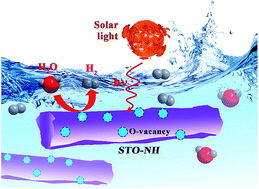Oxygen vacancy engineered SrTiO3 nanofibers for enhanced photocatalytic H2 production†
Abstract
Designing an architecture with the ability to temporarily capture one kind of charge carrier has a critical role to play in enhancing the performance of photocatalytic reactions. Here, we report that SrTiO3 nanofibers that have been treated with a brief method of H2 calcination in an H2/N2 atmosphere (denoted as STO-NH) form oxygen vacancies (OVs) and achieve significant improvement in performance in photocatalytic H2 production without the presence of cocatalysts. These OVs can trap photogenerated electrons, which inhibits the recombination of electrons and holes in both the surface and the bulk, thus improving the photocatalytic decomposition of water. Moreover, the concentration of surface OVs in STO-NH presents volcanic characteristics: the increase with rise in hydrogenation temperature, with a consequent increase in catalytic activity, indicates well-controlled formation of OVs. The existence and concentration of the OVs in STO-NH photocatalysts are investigated qualitatively through electron paramagnetic resonance, high-resolution transmission electron microscope and photoluminescence emission spectra. A reasonable photocatalytic mechanism is proposed that we expect to be able to provide significant guidance for future study.



 Please wait while we load your content...
Please wait while we load your content...